Life with the Lenovo Yoga 2 Pro
by Brett Howse on July 30, 2014 2:00 PM EST- Posted in
- Notebooks
- Lenovo
- Windows 8.1
- Yoga
Design & Chassis
The Yoga 2 Pro continues with the design philosophy of other Lenovo Ultrabooks like the U300s. Rather than imitate a MacBook Air and taper to a thin edge, the styling when closed is more like that of a closed book. The shell of the device is entirely soft touch plastic, including on the bottom. The front lip has an edge with a rubberized coating, which is used as a grip to prevent the device from sliding around when opened up to extreme angles and used in tent mode. The soft touch plastic continues to the interior, where it surrounds the island style backlit keyboard.
The chassis is solid, but the lid has some flex to it. The 0.61" (15.5 mm) frame feels thin but solid, and the 3.06 lb weight is suitable for carrying in a bag. There are only two USB ports, with only one of them being USB 3.0. The 2.0 port can be powered when the device is off to allow charging a smartphone or other device. Lenovo has offered the Yoga 2 Pro in both grey and a vibrant “Clementine Orange”.
Moving from the Alienware, using the Yoga 2 Pro as a laptop is an experience. The keyboard has good travel for a thin device, and the keys have an aural indicator (which I like). The trackpad measures 3.5” x 2.25” (90mm x 57mm) and comes across as quite smooth. As seems to be the standard these days, the trackpad is a clickpad, with no discrete left and right click buttons. While I prefer dedicated left and right buttons on the trackpad, I do see the tradeoff of a clickpad to allow a larger area for the trackpad.
The trackpad supports all of the Windows 8 gestures for charms and app switching, among others. I found these to be a big distraction though, as often when I was typing my palm would brush the trackpad and I would switch to another app. The palm rejection could use some work, but if I disabled all of the gestures I was much happier. In my opinion, they are not really necessary. I have never been a huge fan of trackpads and due to my usage model, I have always preferred the track point available on the ThinkPad lines, or preferably, a real mouse.
The key point of the device is the hinge, which allows the screen to open a full 360° to make the device into a tablet. As I alluded to earlier, we bought this device first and foremost as a laptop. I did not really expect the hinge to be a big deal. I was wrong.
With a touchscreen and Windows 8.1, this device (as you should expect) is just as happy running desktop applications as it is in the modern world of Windows 8.1. For as much as Windows 8 has caused controversy in the computing world, a form factor like this is what I would imagine Microsoft's original plan migrated towards. You can easily switch from laptop to stand mode, and use it completely as a consumption device. If you need to send an email, switch it back, and you’ve got a full keyboard. It is funny how something so simple as being able to open a laptop wider can completely change the way you use it, but that’s the case with the Yoga 2 Pro
Laptop Mode
As a laptop, the Yoga is a device to get things done on the move. It feels as if there is no compromise, unlike some of the other two-in-one devices with a removable keyboard, which can be top heavy since the internals of the laptop are in the screen. Since the internals are still in the keyboard portion of the chassis, it feels and behaves like any other laptop.
Tent Mode
By folding the device like an upside down V, the user can implement tent mode. If the user wanted to do any sort of touch mode activities, tent mode is great because with the rubberized front edge and the V shape the device is extremely sturdy. Pecking at the screen in this mode has no bounce. If you have a flat surface and want to play a touch game, this mode is the best.
Tablet Mode
When I bought the Yoga 2 Pro, I thought it would be nice to be able to use the laptop as a tablet in a pinch, but, like most preconceptions, I was wrong. It can be used as a tablet like this, but the 13.3" screen and 3 lbs of weight can make it unwieldy. The Surface Pro 3 is almost half the weight as a comparison. Furthermore, in this mode the keyboard is tucked underneath, so it is not very comfortable to hold due to your fingers resting on the keys (which thankfully are deactivated when the screen pivots past a certain point). Unless the user is walking around carrying the Yoga, there is almost no reason to ever use it like this. There is one other potential usage scenario for this mode, in that some airlines are now allowing tablets to be used during take off and landing, allowing business travellers to continue working rather than having 20 minutes of downtime.
Stand Mode
For me, stand mode is actually the one mode that changes my paradigm for tablet use. The tablet world has been pushing for lighter devices with smaller screens in order to make it easier to hold them for long periods of time. However my experience has been that the Yoga 2 Pro in Stand Mode is much better for most of what I ever do with a tablet.
This mode makes media consumption great, moreso than a tablet with a cover that doubles as a stand. Folding the keyboard underneath makes for an extremely sturdy base, and the screen can be positioned at any angle that works best for the user. If you have ever tried to watch something in bed on a laptop, the keyboard sits between you and the screen, so it sits farther away. With a tablet, it needs to be held. The ingenious (but in hindsight obvious) solution of an extended range hinge means the user can keep the screen close, have a much larger screen, and not have to hold the device. Though I haven’t had the *cough* pleasure *cough* of flying with it yet, it seems like a good sized device for a cramped economy class seat. Stand Mode makes you rethink how to use a hybrid PC.
 Yoga 2 Pro (left) versus Toshiba Satellite Radius (right)
Yoga 2 Pro (left) versus Toshiba Satellite Radius (right)
For those not sold on the hinge, there is clearly a demand. Since the launch of the Yoga series, several other laptop OEMs have introduced a device with a similar hinge.


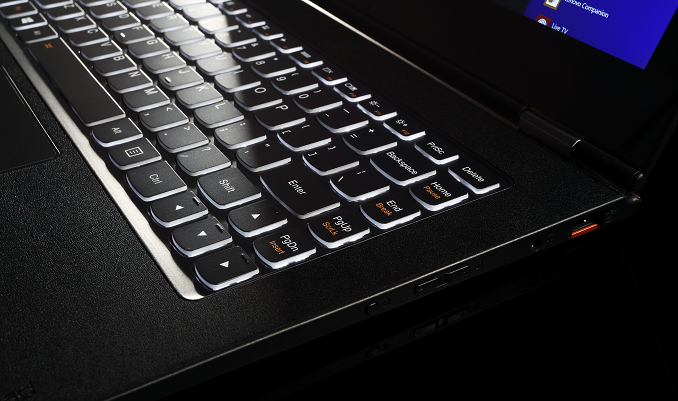
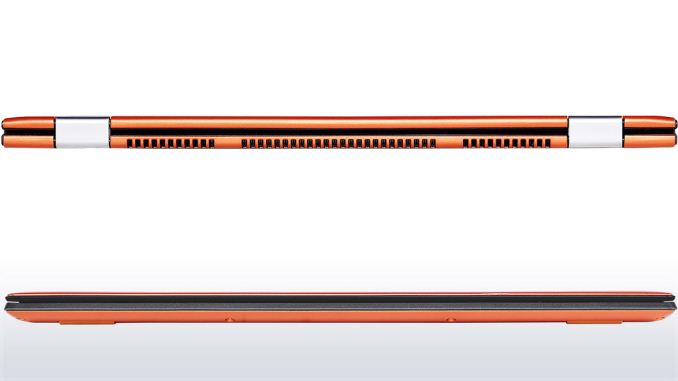
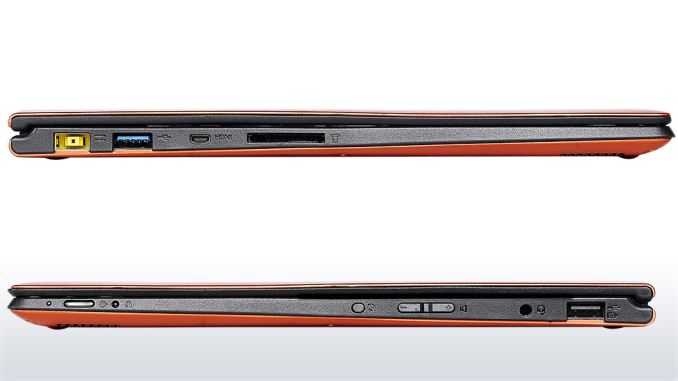
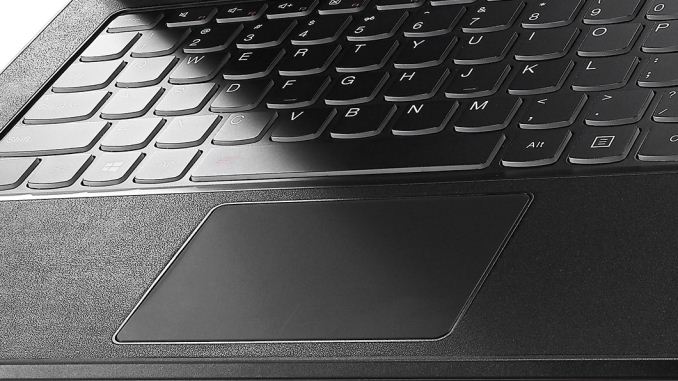
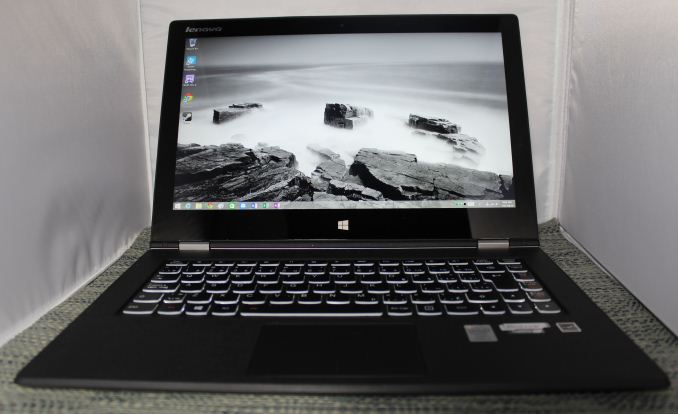
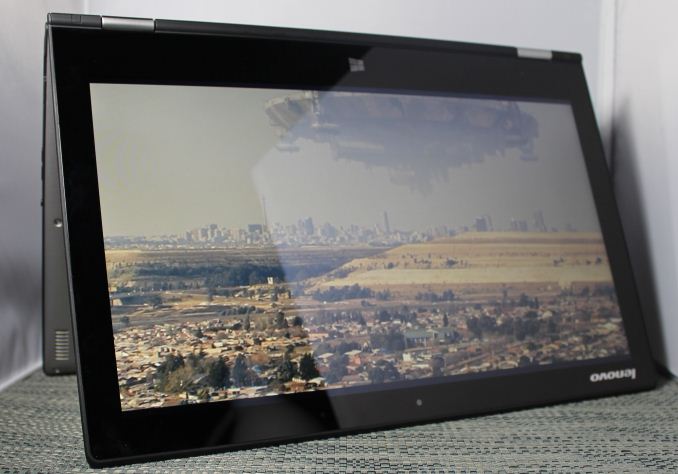
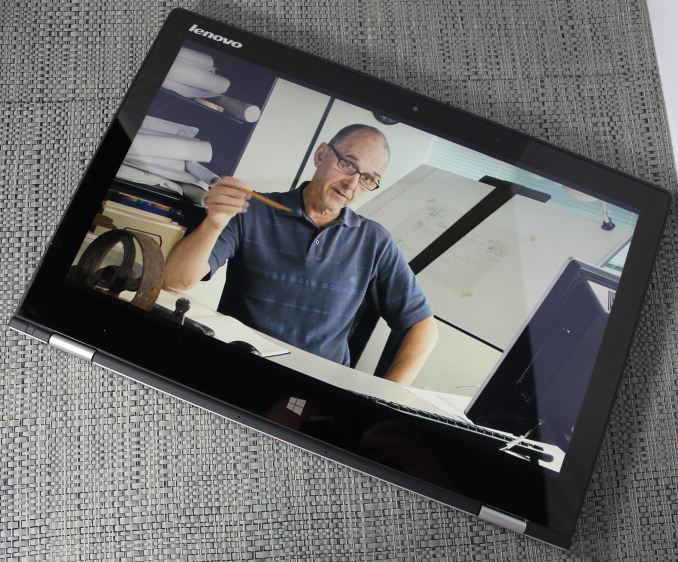
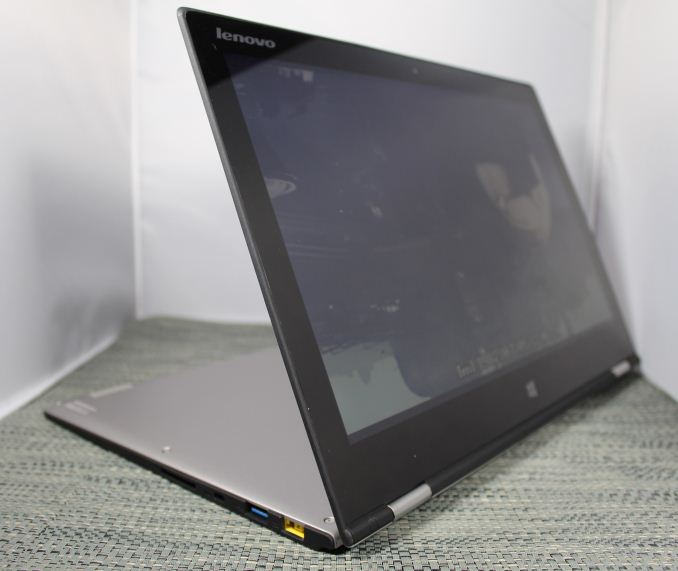








103 Comments
View All Comments
Brett Howse - Wednesday, July 30, 2014 - link
That's great to hear the Wireless is a real drawback on the unit we received. I'm still hoping they will get back to me with the time on when they switched it over. The specs on the website still show the old card so I can't guarantee someone will get AC at the moment.DrShawarma - Wednesday, July 30, 2014 - link
I've been reading this site for quite a while, but this will be my first post.I bought a Y2P about a month and ago and am surprisingly pleased. It's quick, fun and feels good in the hand.
I do however have 2 tiny complaints-
1) Adobe programs won't scale correctly, requiring a microscope to work with. Don't care about that too much though.
2) The trackpad is like a fingerprint\oil magnet, that on the other hand is driving me nuts, how do I clean it? (I tried an LCD cleaning solution with a towel, did nothing)
Brett Howse - Wednesday, July 30, 2014 - link
Adobe showed off their new products with High DPI support at the Surface Pro 3 launch I believe. That's been a big complaint of mine, especially since Adobe should be on top of this because their target market would likely benefit from HiDPI more than the average consumer. Looks like version 13 at the moment but of course that will mean an upgrade cost as well.HighImStan - Wednesday, July 30, 2014 - link
They have since updated their the CPU to i7-4510u and dual band wireless ac-7260 card. I just bought mine, manufactured in mid June, and it hasn't had any wifi issues. Also, uninstalling the McAfee bloatware helped. Still has the greenish yellow though on the display.DigitalFreak - Wednesday, July 30, 2014 - link
Supposedly it's better than it was, but it's just a side effect of the screen technology they chose to use.wpcoe - Wednesday, July 30, 2014 - link
I read that the RAM is soldered to the motherboard, so not user upgradable, but is the SSD user upgradable? I'd prefer the i3 model, but with a larger SSD.KingGheedora - Friday, August 1, 2014 - link
You can upgrade the SSD, it is M.2 slot though. But the SSD it comes with is surprisingly fast. I felt no need to upgrade it (512gb model).Samus - Wednesday, July 30, 2014 - link
My problem with the Yoga is the price. Although they can definitely be had for less than MSRP, they're still more expensive than a Surface 3 WITH a type cover. The rest of the specs, other than the screen size (obviously Yoga is two inches bigger) are about the same, but the Surface has more flexibility. One of my clients picked up both the Surface 2 Pro and a Yoga 2 back in March, and he likes the Yoga 2 more, and perceptively thinks its lighter.But I think the Surface 3 gives it a run for its flexibility.
HighImStan - Thursday, July 31, 2014 - link
I got the Y2P because my Surface Pro 2 was stolen. Originally, I was planning on waiting for the i7 Surface 3 to arrive in August but eventually settled on the Y2P because1) A 256 i7-4650u with HD5000 is $1549 + type cover $130. For around the price of the Y2P, I can only get 128 i5-4300u with HD 4400 $999 + type cover $130 and only 4gb of ram too! Y2P was only $1200 for i7-4510u with HD4400 and 8gb. I'm on a tight budget this month so Y2P got me the best bang for the buck.
2) My Surface 2 Pro kept having connection issues with the type cover. Brought it to Palo Alto's Microsoft store and they have no idea what was wrong. I played with some of the Surface 3 for an hour and found connection issues that was on and off with one of the displayed Surface 3. I was about to bring back my Surface Pro 2 for fixing after my Fourth of July vacation but it was stolen. So in a way, losing that device is a blessing in disguise...I was able to discover Y2P.
3) I never took off the type cover on my Surface Pro 2 anyways so the Y2P doesn't pose a problem. I treated the SP2 like the Y2P anyways by bending back the keyboard and using it as a laptop. Only difference, I don't have to worry about problems of keyboard connection. Only thing I miss from my SP2 is the mini display port (better than the micro hdmi imo) and the ability to change the keyboard lighting's brightness. Yes, it was lighter too but the weight of the Y2P never bothers me.
Samus - Thursday, July 31, 2014 - link
That's crazy about your connection issues. I have dozens of clients with Surface 2's and none of them mentioned that. A firmware update fixed some wifi issues people were having back in March though.As far as price, nobody pays retail for Surface. They can always be had for 20% less (just like the Yoga 2) but with that in mind, I agree that it's only really competitive at the base level. But that's where most people are buying, anyway.
I just picked up a Surface 2 256GB 8GB i5 for $800 new with a type cover on eBay... That was a buy-it-now too. There's a lot of auctions for used ones that include BOTH covers for even less.